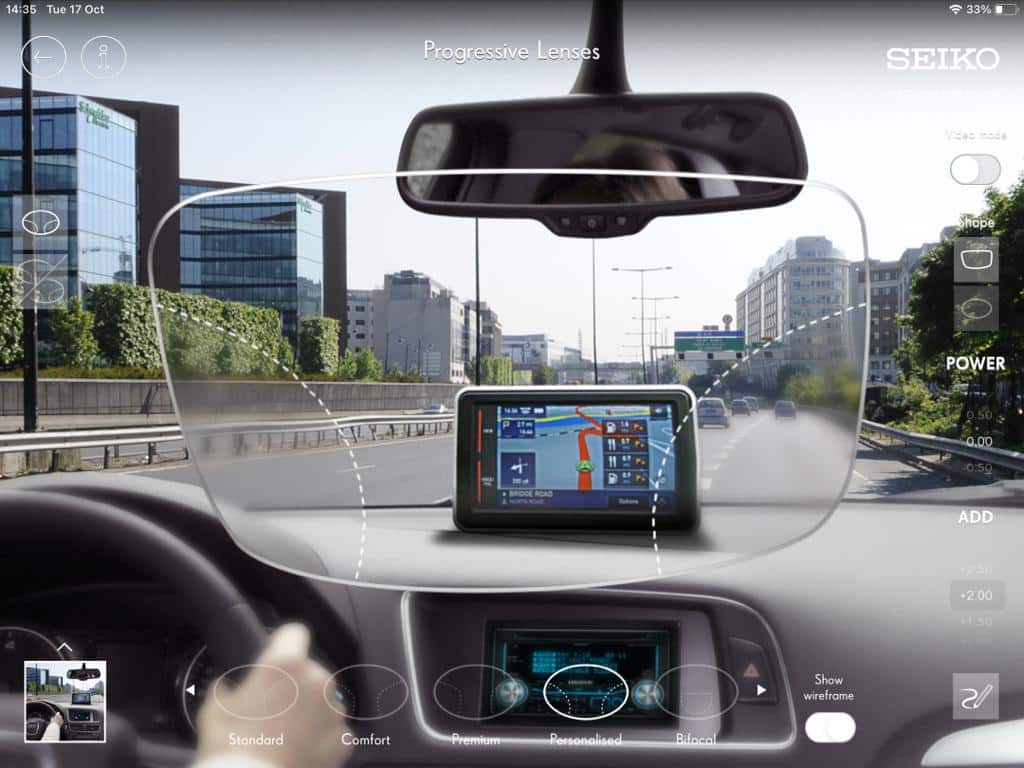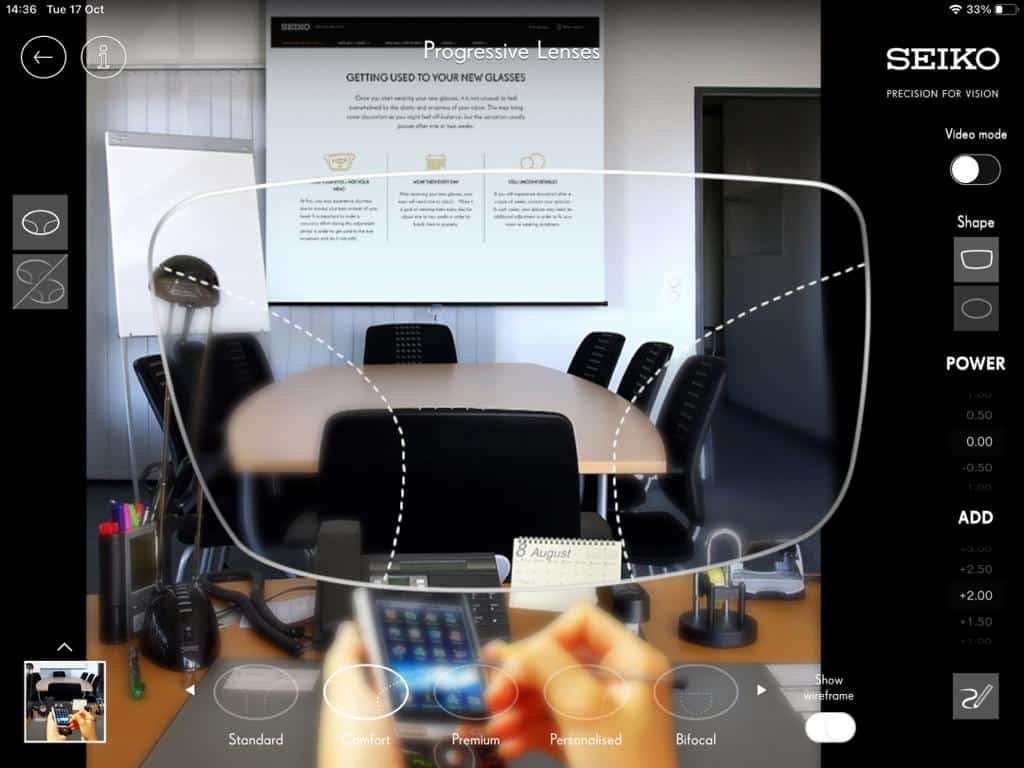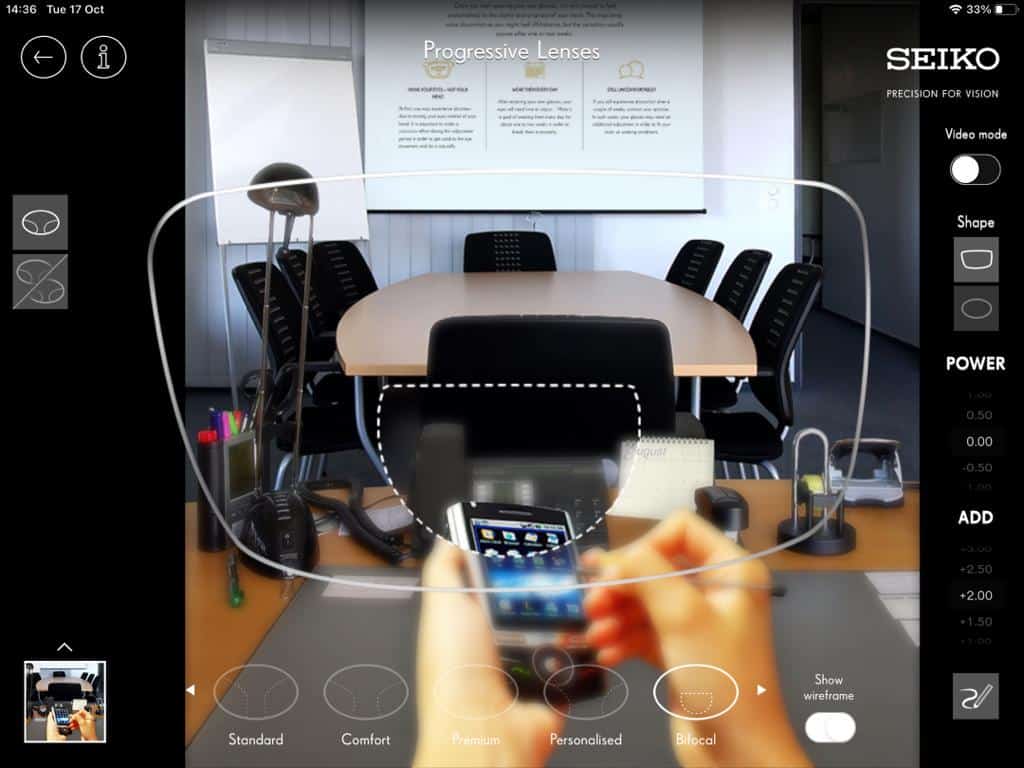17-10-23 By: Michael Stent
Varifocal Lenses: The Ultimate Guide
The Ultimate Guide to Varifocal Lenses
In this blog post, we will dive into all the important topics that relate to varifocal lenses, from availability, advantages and disadvantages along with how to best take care of your varifocals.
The history of varifocals
Varifocal lenses, also known as progressive lenses, have revolutionized the way we correct vision, offering a seamless transition between near, intermediate, and distant vision. But have you ever wondered how these remarkable lenses came into existence? In this blog, we’ll take you on a journey through the fascinating history of varifocal lenses, from their humble beginnings to their modern-day innovation.
-
The Early Beginnings
The concept of varifocal lenses can be traced back to the early 20th century when individuals with presbyopia faced the need for multiple pairs of glasses to address different visual requirements. Pioneers in the field of ophthalmology and optics recognized the inconvenience of constantly switching between reading glasses and distance glasses. This spurred the quest for a solution.
-
The Birth of Bifocals
Before varifocal lenses, Benjamin Franklin is often credited with inventing bifocal lenses in the late 18th century. Bifocals had two distinct areas in a single lens, allowing wearers to shift their gaze between near and far distances more easily. Although this was a significant step forward, the noticeable line dividing the two sections remained a drawback.
-
Progressive Advancements
The 20th century saw a series of progressive developments in the field of optics. The first truly progressive lenses, where the transition between prescriptions was seamless, emerged in the early 1900s. A key innovator in this era was Carl Zeiss, who introduced the Punktal lens, featuring a gradient of prescription strengths across the lens surface. This represented a substantial improvement over traditional bifocals.
-
Modern-Day Varifocal Lenses
Varifocal lenses as we know them today have come a long way from their early predecessors. Advances in computer-assisted design and manufacturing technology have allowed for the creation of highly sophisticated, personalised varifocal lenses. These lenses are tailored to an individual’s unique visual requirements, ensuring optimal comfort and visual clarity.
-
The Future of Varifocal Lenses
As technology continues to advance, so do varifocal lenses. Manufacturers are constantly refining designs, making them more compact, and improving the clarity of vision across all distances.
Varifocal lenses have come a long way from their inception, simplifying the lives of millions of individuals with presbyopia. From the bifocals of Benjamin Franklin to today’s cutting-edge, personalized varifocal lenses, the history of these lenses is a testament to human ingenuity and our commitment to enhancing vision. As technology continues to advance, we can only anticipate more remarkable innovations in the world of varifocal lenses, ensuring that our vision remains sharp and clear, regardless of our age.
When do you need varifocal lenses and why?
Varifocal lenses are required by people who in their early forties require different prescriptions for distance vision tasks such as driving and watching television and another prescription for reading.
This is due to Presbyopia, a common optical quirk, typically making its debut in our 40s. This is because our crystalline lens loses it’s flexibility gradually over time and this flexibility is what allows our eye when we are younger to change its power so that we can read and see things up close.
After losing a small amount of this flexibility each year of our lives eventually when you reach your early forties it no longer has enough flexibility left and therefore nearby objects appear blurred.
Suddenly, the once-clear print in a book becomes an enigmatic dance of squints and stretch-out-arm tactics, pushing us to reach for a trusty pair of reading glasses or often for those in denial, a friend or partners reading glasses.
In the grand play of life, presbyopia is merely a gentle reminder that we’ve joined the ranks of those who’ve earned the right to embrace reading glasses as a symbol of our wisdom and experience.
How do varifocals work?
Varifocals work by incorporating multiple prescriptions into a single lens. The top portion of the lens is designed for distance vision, while the bottom portion is for near vision. The middle section of the lens is for your intermediate vision, this is anything you are viewing between 1 and 2 meters. This allows clear vision at all distances. This smooth transition eliminates the need for multiple pairs of glasses, making varifocals a convenient choice for individuals with varying vision needs.

Differences between varifocal designs
Varifocal lenses, may seem similar on the surface, but there can be significant differences between designs and manufacturers. These variations are primarily related to the lens design, technology, and manufacturing processes. Here are some key differences to consider when comparing different varifocal designs:
Personalisation: The major lens manufacturers offer personalised varifocal lenses, which are customized to an individual’s specific prescription, unique visual needs and frame fitting. Whether distance vision is a priority, intermediate, or near these lenses can be redesigned to offer you the best possible vision for your required preference. For personalised lenses extra measurements these include Back Vertex Distance which is the distance from the front of your eye to the back of the lens, Pantoscopic Tilt which is the angle the frame sits on your face and finally the curvature of the frame is measured.
Freeform Technology: Many modern varifocal lenses use freeform technology, which involves precise digital surfacing of the lens. This technology allows for more complex lens designs and better optical performance.
Peripheral Distortion: To put it simply each time a lens manufacturer brings out a new varifocal design they are aiming to reduce this peripheral distortion to give you the widest possible areas of clear vision from distance to intermediate. These areas are areas of soft focus that aren’t your exact prescription and therefore responsible for that “swimmy” sensation you may have heard varifocal wearers speak about.
Corridor length: The final customisation on a varifocal is the corridor length the is the distance from the pupil centre to the top of the reading area. This is the area of the lens used for intermediate vision. Corridor lengths generally range from 10mm to 14mm. The longer the corridor the longer the area of clear intermediate vision available on the lens.

Importance of correct fitting
It is essential that varifocals are fitted correctly as any errors in fitting can result in poor overall vision. We recommend all varifocals are fitted by a qualified dispensing at your local optician.
Advantages of varifocals
Varifocals offer several advantages, one of the main advantages is the seamless transition between distance and near vision. With varifocals, there is no need to adjust or switch between different pairs of glasses, providing convenience and ease of use.
Another advantage of varifocals is the aesthetic appeal. The absence of a visible line on the lens gives varifocals a more natural and attractive appearance. This makes them a preferred choice for individuals who want to maintain their style and avoid the telltale signs of their age.
Additionally, with varifocals, you can see clearly at all distances, including intermediate vision. This is particularly beneficial for activities such as using a computer where clear vision at intermediate distances is required.
Disadvantages of varifocals
While varifocals offer numerous advantages, they also come with a few disadvantages that should be considered. One of the main challenges with varifocals is the adjustment period. Due to the progressive nature of the lens, it may take some time for your eyes to adapt to the lens design alongside your new prescription. However, the number of people we find that don’t adapt to varifocals to be very small and that varifocals are definitely worth persevering with the initial adaption period.
It is also worth noting that some individuals may find it challenging to use varifocals for certain tasks or activities that require precise near or intermediate vision, such as sewing or detailed craftsmanship or who use multiple computer screens at eye level or above at work. In such cases, a dedicated office lens would be the recommended solution.
Tips for adjusting to your varifocals
The time it takes to adapt to varifocals is different for everybody some people adapt almost instantly while others may take much longer up to a month or so, especially if they are new to wearing varifocal glasses. Here are a few tips to help you adapt more quickly:
- Give yourself time: It is normal to experience some initial discomfort or unease when transitioning to varifocals.
- Move your head: With varifocals, it is important to remember to move your head instead of just your eyes when looking in different directions. This will ensure that your eyes don’t wonder in the extremities of the lenses where the areas of peripheral distortion are located
- Start with simple tasks: When first wearing varifocals, start with simple stationary tasks such as reading or watching television. As you become more comfortable, gradually introduce more visually demanding activities.
- Communicate any issues: If you are experiencing persistent discomfort or visual problems with your varifocals, don’t hesitate to contact your optician.
The best varifocal lenses
There are a number of top-quality bespoke varifocals on the market at the moment, these include:
- Seiko’s Brilliance lens which is designed in Japan and incorporates their Personal Design Selection System and first of it’s kind Balance Zone Technology which reduces the magnification or minification caused by high prescriptions.
- The Neurogran lens from Japanese optical lens specialists Tokai incorporates new N-link system and super flexible inset.
- Nikon’s SeeMax Ultimate lens is a market leader for those who want the quickest possible adaption.

How much are varifocal lenses?
As not all varifocals are made equal there is a wide range of cost anywhere from £150 up to £825 for a top quality varifocal lens.
Top quality varifocal lenses would offer minimum distortion, the widest area for intermediate and reading, along with the thinnest and lightest lens material for maximum comfort and top quality anti-reflection coated lens with a hard coating built in to prevent scratches, UV protection, hydrophobic qualities as well as a years warranty against scratching.
Bespoke varifocal lenses are worth the investment so we recommend investing in the best lens design you can. You will see the benefits every day.
Can you get varifocal sunglasses?
Yes, varifocals are available as sunglasses. With the option of a large number of tint colours, from your traditional green lenses to more statement purples and blues.
What options can you add to your varifocal lenses?
Varifocals are available with a variety of extra’s to suit your specific visual needs and tasks.
Coatings: These include traditional anti-reflection coatings for people who wear their glasses all day everyday. Blue-light filter coatings to make working on a digital device for long periods of the day more comfortable. Night-driving coatings designed to reduce the glare from car headlights.
Sun Protection: Varifocals are available in both photochromic lenses which reactive with the UV in the atmosphere to change from light to dark dependent on your surroundings. As well as Polarised sun lenses which protect your eyes from bright sunlight as well as any reflected glare of shiny surfaces like glasses, sea or a wet road.
How to care for your varifocal lenses
Like all prescription glasses, there are a number of steps we recommend you follow to make sure your frames and lenses stay in tip top condition for as long as possible.
- Clean your lenses daily: To avoid any debris or particles scratching the lens run the lenses under luce warm water and then wipe dry using a microfibre lens cloth and once dry wipe all over the lenses using a fresh microfibre cloth.
- Avoid Extreme Heat: If lenses are exposed to extreme heat the anti-reflection coating will break down so please don’t wear your glasses in steam rooms or leave them in direct sunlight on your dashboard, this will also misshape the frame.
- Store correctly: When you aren’t wearing your glasses always store the frames face up.
Can you get varifocal contact lenses?
Yes, all of the market-leading contact lens manufacturers including Alcon, Johnson & Johnson, and Coopervision make varifocal or multifocal contact lenses so there is plenty of choice. Our optometrists here at Ace Eyewear will recommend the best fitting and material of lens to give you the ultimate comfort and the highest level of vision.
Alternatives to Varifocals: Bifocal Lenses
What are Bifocal’s?
Bifocals are lenses that incorporate two different prescriptions one for distance vision and the other for reading.
Advantages of bifocals
One of the main advantages of bifocals is the clear distinction between the distance and near vision zones. The visible line on the lens makes it easy to switch between the two prescriptions, providing clear vision for different activities.
Another advantage of bifocals is the affordability. Bifocals are generally less expensive compared to varifocals due to their simpler design and manufacturing process. If cost is a deciding factor for you, bifocals may be a more budget-friendly option.
Disadvantages of bifocals
Despite their advantages, bifocals also have some limitations that should be taken into consideration. One of the main disadvantages is the visible line on the lens. While the line serves its purpose of separating the two vision zones, it can be visually distracting and may affect the overall appearance of the glasses.
Unlike varifocals that offer clear vision at all distances, bifocals do not have a dedicated intermediate zone. This can be a drawback for individuals who frequently engage in activities that require clear vision at intermediate distances, such as using a computer or playing a musical instrument.
The final drawback is that range of additional options available on your bifocals is very limited when it comes to adding things like transitions, polarised and high index lenses.

Bifocal Types
The reading segment of a bifocal is available in a variety of shapes and sizes but the two most common are the D-top or flat top and the round segment. The size of the segment varies from 28mm wide to 45mm wide.
If you are looking to update your varifocals or thinking about wearing them for the first time please book an appointment with our dispensing optician who will be happy to help.


